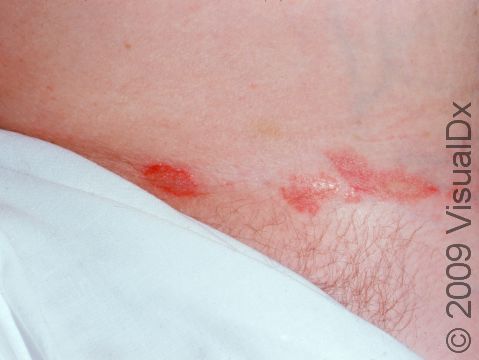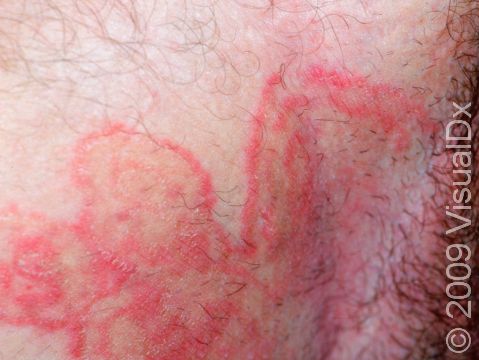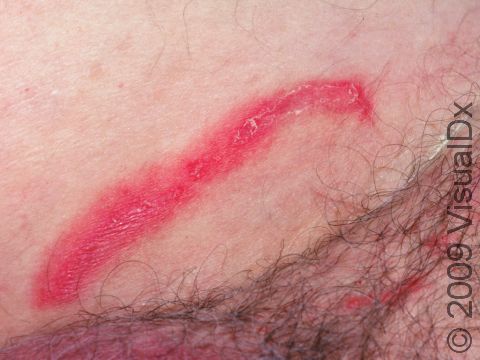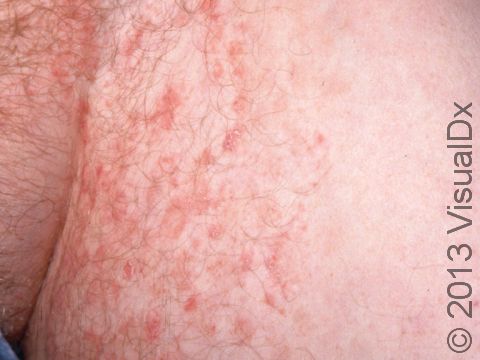Jock Itch (Tinea Cruris)
Tinea cruris is the medical term for jock itch, which is an itchy fungal infection of the skin of the groin. The rash of jock itch usually begins in the top creases of the thigh as raised, red, itchy patches and may become pink or red, flaky or bumpy as it spreads. The fungus (Trichophyton rubrum) is the same as that which causes other types of ringworm, including athlete’s foot, so anyone with any type of ringworm may spread the infection to other areas on the body.
Jock itch is easily treated, though it is contagious so it is best to avoid intimate contact or sharing of towels or clothes until it has gone away.
Who's At Risk?
Jock itch is very common; it is usually seen in teen and adult men, particularly in those in warm, humid climates. It is also very common in athletes, especially those who wear tight athletic gear (like a jock strap). Jock itch can also be seen in people who are overweight or diabetic.
Signs & Symptoms
Large, round, red patches, with bumpy, scaling edges occur in the groin and may extend down the inner thigh or onto the belly or buttocks areas. Jock itch is usually not present in the genital area. It is usually a very itchy rash.
Self-Care Guidelines
Check your feet and treat athlete’s foot if it is present, as it can often spread from there.
Over-the-counter antifungal creams such as miconazole (eg, Monistat®), clotrimazole (Lotrimin®), or tolnaftate (Tinactin®) are very effective. Apply it twice a day until a few days after the rash seems to be gone, which usually takes about 2–3 weeks. You may still see flat, brown areas of discoloration for several weeks, but these do not need to be treated as long as there is no longer itching or bumps and scales in the area.
Reinfection can be prevented. Keep the area cool and dry by drying the body thoroughly after bathing and wearing loose cotton clothing. Wash your clothing and linens in hot water. If you think you also have athlete’s foot, use a separate towel for your feet and try to keep your feet dry as well, by avoiding wearing shoes for long periods or wearing loose-fitting shoes. Clean your bath/shower with bleach and floors with an appropriate cleaner to kill any fungal spores. You should also avoid sharing clothing and wear footwear in public bathrooms/showers and gyms. Skin folds can be a continually moist environment that aids growth of this fungus. If this is a recurrent problem for you, it may help to lose weight.
Treatments
Your doctor may do a scraping to look for fungus under the microscope or a biopsy if your diagnosis is uncertain.
Antifungal creams or pills may be prescribed.
Visit Urgency
If you see no improvement after 2 weeks of self-care, see your doctor.
References
Bolognia, Jean L., ed. Dermatology, pp.1174-1185. New York: Mosby, 2003.
Freedberg, Irwin M., ed. Fitzpatrick’s Dermatology in General Medicine. 6th ed. pp.1999, 1102. New York: McGraw-Hill, 2003.
Last modified on August 16th, 2022 at 2:44 pm

Not sure what to look for?
Try our new Rash and Skin Condition Finder



